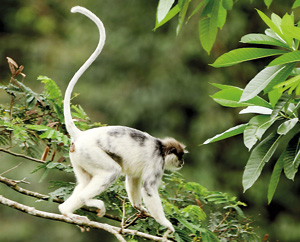In his book The Natural History of Ceylon (1861), Sir Emerson Tennent says, “A white monkey, taken between Ambepussa and Kornegalle, where they are said to be numerous, was brought to me to Colombo. So striking was its whiteness that it might have been conjectured to be an albino, but for the circumstance that its eyes and face were black”.
Tennant also mentions that he has heard of White Monkeys from Ridi-galle Wihara in Seven Korles and in Tangalle. Robert Knox in “Seeing Ceylon’ written in 1681 too makes mention of them - “Milk-white both in body and face; but of this sort there is not plenty”.
Are they still there in Sinharaja and its environs?
This is the discovery that members of the Wildlife Conservation Society of Galle (WCSG) have reported during their recent research studies in the area. “Some of them have a completely white coat and it is like large snow balls falling from the sky when they leap from the canopy of large trees in Sinharaja,” said a researcher of the spectacular sightings of white monkeys in lesser explored areas of the rainforest a few months ago.
Albino or white monkeys are recorded intermittently, but researchers of the WCSG found 30 individuals who are either completely or partially white from 14 monkey troops they had studied in this area. All were recorded within an 18 km stretch in and around home gardens around Sinharaja.
These monkeys are a different colour morph to the endemic Purple-faced Leaf Monkey known as ‘Kalu Wandura’ in Sinhala. Some are completely white while others have mixed coats. The babies of some of the white mothers are black while the reverse too has been observed in the wild. The discovery was made by the researchers of the WCSG while they were studying the Southern Purple-faced Leaf Monkey (Semnopithecus vetulus vetulus).
President of WCSG Madura De Silva explained that this colour morph named the Galanthus colour morph is a snow-white colour variant of the same species. The researchers also say that the monkeys are not albinos as none had red eyes. All had black naked parts of the face and beige to ashy brown crown hair, observed these researchers.
Well known environmentalist Rohan Pethiyagoda, says this is due to a phenomena known as leucism. Leucism is a condition characterized by reduced pigmentation in animals that gives colour to their skin and fur. In the case of albinism, it is the reduction of a skin pigment melanin, but in this case a reduction in all types of skin pigments occur. “Clearly the leucistic gene has been spreading across several troops and may even be selected, if males prefer white females.
But these kind of white animals are unusual in the wild probably because a white animal is conspicuous and more likely to be preyed on, so it would be interesting to see how these monkeys do in the long term,” Pethiyagoda said.
There are four different subspecies of this primate in addition to the Southern Purple-faced Leaf Monkey namely Mountain purple-faced leaf langur (Semnopithecus vetulus monticola), Western purple -faced leaf langur (Semnopithecus vetulus nestomr), and Northern purple- faced leaf langur (Semnopithecus vetulus philbricki). They are found on different regions of Sri Lanka and the Southern subspecies distribution is from Kalu Ganga to Ranna as per mammalian expert W.Philips.
From 2007 the primate research team of the WCSG has been studying the distribution, feeding ecology and behaviour of Southern Purple-faced Leaf Langur. Twenty six troops from rain forests and home gardens around Galle and Matara Districts have been observed so far.
Researchers were first tipped off about the ‘ghost like’ white monkeys by the villagers who go into the forest to extract the kitul sap. Trusting the locals, they decided to follow their paths into the forest and after a few weeks came upon the white monkeys that live in the treetops, rarely descending to the ground.
In the National Museum primate specimen collection is a pale-coloured specimen found by W.Philips from Matara District showing that there was colour diversity among the Southern Purple-faced Leaf Langur even in the early 1900s.
“These historical accounts also have inspired us to keep our eyes open in finding white monkeys from southern Sri Lanka through our primate research,” said Madura. Their research is funded by Nations Trust Bank. |


